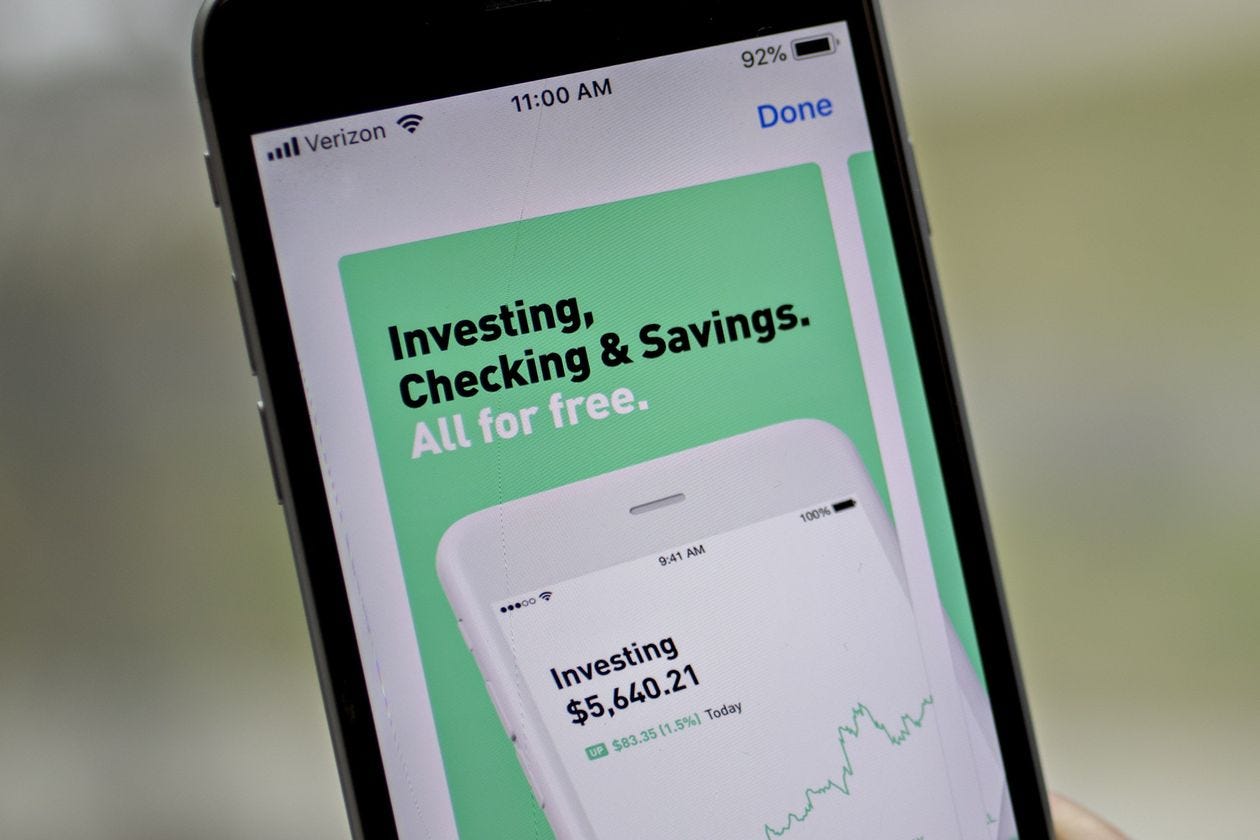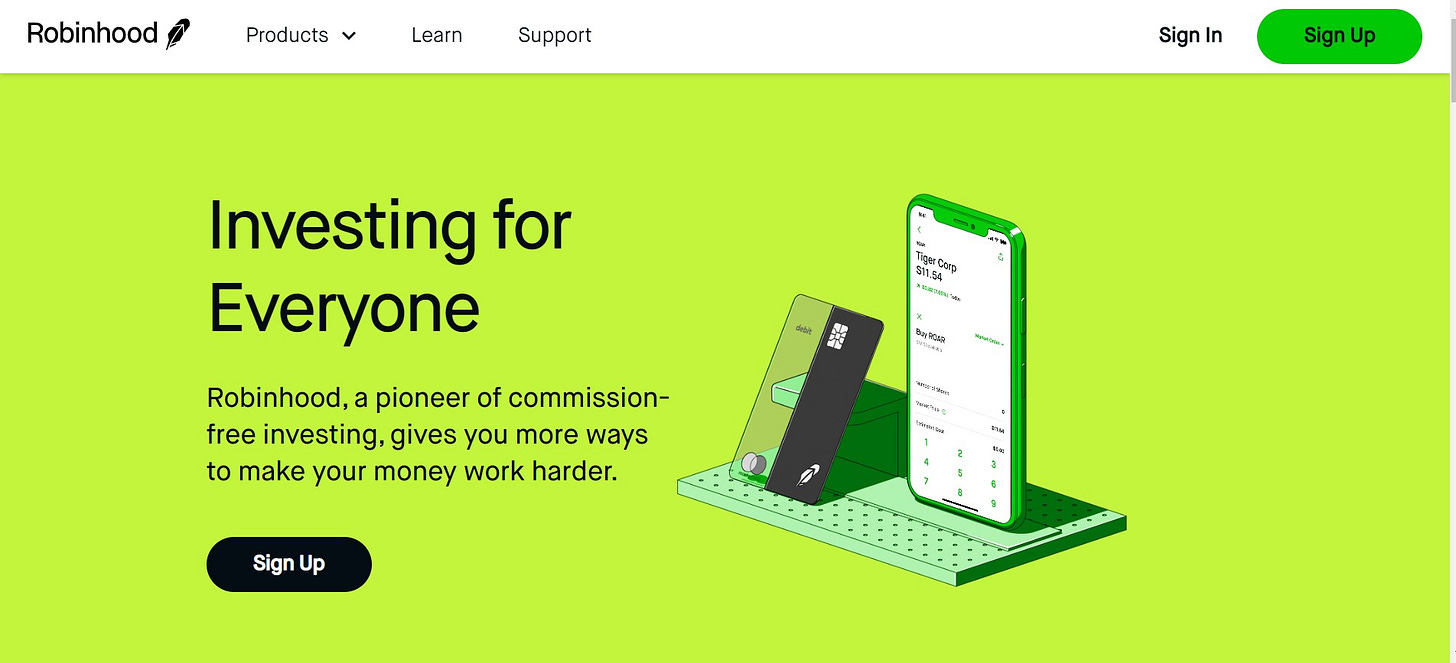
“Money won is twice as sweet as money earned.” — Fast Eddie Felson (Paul Newman) in The Colour of Money
Outside the small enclave of the Belarusian Premier League, it’s been a barren few months for sport and with it, for sports betting. To fill the void punters had to look for something else to wager on. They found the stock market.
March and April saw record trading activity flow through retail brokers in the US. The big four online brokers executed as many trades for customers in those two months as in the whole first half of last year. This week, two of the big brokers gave indications that activity levels remained high in May.
Much of this trading was driven by new customers. Used to winning ~200k new customers per month, the four online brokers picked up a million new customers over March and April. Outstripping them all though was Robinhood, the app-based pioneer of zero fee trading. In spite of an outage in March that locked customers out for an entire trading day, it recovered to win over 3 million new customers and complete a US$280 million fundraising, valuing it at US$8.3 billion. Since the beginning of April it has been averaging 2 million daily active users per day with no drop-off as yet evident.
Although retail money is still dwarfed by institutional money, its contribution to total market flows has gone up. Assuming the number of shares behind each trade has remained constant, retail’s share of total stock market volumes was 40% higher in March/April than it was in 2019. Retail flirtation with the stock market peaked in 2001 when 21% of US households owned shares and has been coming down ever since, to below 14%. That may now be turning.
Of course, there are multiple reasons why retail interest in the stock market may have gone up. Some investors may have been seduced by the fall in the market in March to buy the dip. Stimulus cheques would have helped — in the week after receiving their cheque people in the US$35-70k income bracket traded stocks ~90% more than in the week before.
But a pivot from sports is a compelling explanation. The demographic of Robinhood’s customer base is similar to that of a sports bettor. Men aged 25-34 are the segment most likely to bet on sports on a regular basis. According to Deloitte 43% of North American men aged 25-34 who watch sports also bet on sports at least once per week, and that’s the same group that has flocked to Robinhood. The median age of a Robinhood customer has drifted up from 27 in 2017 to 31 now, and 80% of them are men.
Indeed, Robinhood’s interface makes the transition between sports betting and trading seamless. The app has been compared to a mobile game (“Charles Schwab, meet Candy Crush,” according to an NBC News report) which users check ten times a day or more.

Robinhood customers also appear to be attracted to stocks for the same reasons they are attracted to sports events. In its S-1 prospectus DraftKings, a sports betting company, says that it delivers “betting experiences designed for the ‘skin-in-the-game’ sports fan — the fan who seeks a deeper connection to the sporting events that he or she already loves.” A look inside Robinhood portfolios reveals the sorts of companies that customers no doubt have deep connections to. Outside of the ‘cheap’ stocks (Robinhood gives away a free share, priced between US$2.50 and US$10, to every new account holder) portfolios are stuffed full of Aurora Cannabis, Disney, Snapchat, Tesla, Twitter. (Very few banks and financial services companies are in there.) On the basis that their customers love sports betting, there’s something meta about DraftKings itself having worked its way into more Robinhood portfolios than practically any other stock over the past month.
To juice their returns Robinhood customers use leverage. Having eliminated trading commissions, margin loans are one of the main ways for the company to make money. At end 2019, its margin lending book was US$657 million – not huge, but equivalent to ~3% of estimated customer assets, which is proportionately larger than ETrade’s or Ameritrade’s.
The same pattern has played out in other parts of the world. Plus 500, an online service provider for trading Contracts for Difference (CFDs) internationally, put up monster results for its first quarter. It made in one quarter ~90% of the revenues it made in the whole of last year. Those revenues came on the back of more customers, higher customer activity and came with lower customer acquisition costs. Continued customer acquisition and high deposit levels going into the second quarter set the company up well for continued strong performance.
Here the semblance to gambling is clearer. The company acts as principal to its clients’ trades and across the industry ~80% of customers lose their money. In addition, customers have very short holding periods — the median client trade duration is less than an hour.
The preference of US retail to trade underlying cash exposures rather than CFDs on commodities like in other markets is driven by regulation. One benefit is that it delivers a cost of capital advantage to American companies. Having been hoovered up into Robinhood accounts, DraftKings now trades at 11x management’s fully ramped EBITDA target, which is more than seven years out. That compares with Flutter, which languishes in London on the same multiple three years out. In the same space GAN, a B2B provider of software and services to the gaming industry, relisted from London to NASDAQ and has seen its share price go up >50% since.
The poster child of this pivot from sports to the stock market is Dave Portnoy. With no sports to bet on he funded his ETrade account with US$3 million in March and livestreams his day trading sessions to his 3.9 million Twitter and Instagram followers. “For a gambler, investing has a ton of similarities,” he said.
He raises an interesting question: Are the industries that different?
There has always been crossover in terms of personnel and philosophy. Ed Thorp took the Kelly criteria from blackjack to the stock market; Michael Mauboussin has written of the many parallels in his book, The Success Equation: Untangling Skill and Luck in Business, Sports, and Investing.
But there is a crossover of business models, too. Bookmakers are similar to insurance companies, playing on one side of a risk market. They select risk like insurance companies do and they lay it off with other participants in the same way that primary insurers use reinsurance. Unlike insurance companies though they hold customer funds for too short a period of time to generate investment returns and so rely solely on underwriting risk to make money. In those terms New Jersey sports books make a 6.4% underwriting profit, except that they call it gross gaming revenue.
Over the past twenty years the betting world has borrowed other business models from finance. Betfair was founded in June 2000 as a multi-sided betting platform, modelled on a stock exchange. Before it emerged, bookmakers were relatively consolidated on one side of the market while punters were fragmented on the opposing side. While other models at the time also looked to cut out the middleman – notably Flutter, which was better funded – Betfair’s founders understood the importance of driving liquidity through the platform. They restricted trading to certain standardised markets, presented odds in decimals to reduce trading increments, aggregated bets for volume and opened themselves up to ‘market makers’ — punters who were willing to expose themselves to a book by laying bets.
Betfair went on to acquire Flutter in December 2001 and revived the brand as the holding company’s name in 2019 after incorporating Paddy Power, Fanduel and later Stars Group. Reflecting the adjacency of the industries, its founders went on to back many fintech companies (including Funding Circle, Revolut and Prodigy Finance).
Today the ecosystems in both industries look remarkably similar. Both systems function well because of heterogeneity in their user base. Punters operate alongside sophisticated players — firms like Starlizard in sports betting. Just like in financial services a lot of value can be created greasing the ecosystem. GAN and Playtech both provide infrastructure technology in sports betting the way that Bloomberg and Stripe provide it in financial services.
Indeed the two industries can converge if sports betting is seen as an asset class. A 2016 paper by analysts at Long Rock Capital concluded that a systematic sports betting strategy can outperform hedge fund managers and the S&P 500 index.
The question is whether having seen betting borrow extensively from finance, the pendulum is now swinging the other way. Most industries are catering to more short termist tendencies. An alternative explanation for banks’ under-performance versus other industries is that they aren’t. Long ‘fast’, short ‘slow’ has been a profitable trade.
Byrne Hobart wrote this week about how media companies strive to fill consumers’ ‘dead time’, with the fifteen second to fifteen minute chunk a growth category. Sports betting fills it and so does mobile stock trading. As well as making the interface prettier, by reducing commissions to zero and introducing fractional share trading, Robinhood has removed a lot of the friction involved. Customers may lose money, but so what? Plus 500 historically churned its customers at a high rate (64% last year) but makes money by picking them back up cheaply (420% three-year ROI on 2017 marketing spend).
This is also the reason why robo advisors can’t be successful. There is an inconsistency in encouraging long term investment behaviour via an app primed to be checked multiple times a day. The more frequently you look at your portfolio, the greater the chance you’ll see a loss. Nassim Taleb did the maths in his book, Fooled by Randomness, published before mobile investing was a thing. In a hypothetical portfolio with a 15% annual return and 10% standard deviation, the likelihood of seeing a gain once a year is 93%. Check every second, minute or hour, and the likelihood of seeing a gain drops to 50%, which means you are just as likely to see a loss.
Sports are coming back and the anticipation is palpable. Not usually fans of the German Premier League, English football fans have been downloading the Budesliga Fantasy football app in record volumes. How fungible funds are between the markets remains to be seen. But dopamine is a big industry and narrowly-defined entertainment does not have a monopoly.
Marc Rubinstein is an angel investor in fintech and writes on financial sector themes. He is a former hedge fund manager at Lansdowne Partners, one of the oldest long/short hedge funds in Europe. Prior to that, he was a managing director of Credit Suisse, one of the youngest in his cohort. He started off as an equity research analyst at BZW (investment banking arm of Barclays) specialising in banking sector and moved to Schroeders.


